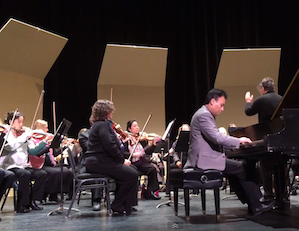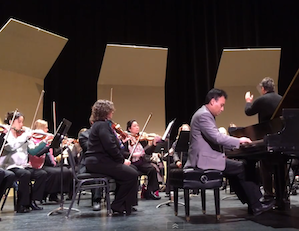
Everything feels free and easy at a San Francisco Chamber Orchestra concert. It begins at the door, where no admission is charged. Then, with the affable and ingratiating conductor Benjamin Simon in charge, there’s not a trace of stuffy formality to be found. The audience at a recent performance responded in kind, with unrestrained applause between movements.
In the ensemble’s warm-hearted year-end program, "The Virtuosi," Simon chatted with the two concerto soloists on the bill. Jared Pabilona, an 18-year-old senior at San Jose’s Pioneer High School, told a large audience at the Nourse Theatre that he had first “wanted to do that jazz thing” when he took up the double bass. And no, he answered Simon’s impish question, he didn’t mind lugging his big instrument around
Pianist (and fellow San Jose native) Jon Nakamatsu got his Q&A turn after intermission. “I don’t have musical degrees,” said the against-all-odds winner of the 1997 Van Cliburn Competition. “I’m really not qualified to be standing here today.”
Moments later, after admitting that he sometimes was too busy to practice when he was teaching school, Nakamatsu tore through a performance of Saint-Saëns’ Piano Concerto No. 2 that was the aural equivalent of a full-on fireworks display. If that’s what not being qualified and not practicing can produce, bring it on.
The program itself offered further evidence of an organization going its own merry way. Who else, in a season suffused in Messiahs and Nutcrackers and other sacred music or tinsely confections, would serve up such a lush, unusual dish as Giovanni Bottesini’s 1845 Double Bass Concerto No. 2?
The good news about all this is that there’s nothing the least bit loosey-goosey about the thing that really matters — the performances themselves. Right away, with a pert and attentive reading of the Overture to Le Nozze di Figaro, this 60-year chamber orchestra proved to be disciplined, nimble, and expressive.
Positioned under a canopy of sound reflectors that moved over to the Nourse from the Herbst Theatre (currently shuttered for a seismic retrofit), the SFCO strings produced a light but bright and focused sound. The woodwinds and brass made a distinct contribution in the Mozart, smoothly melded with the whole. Only the timpani sounded a little remote, an acoustical effect that may have been less noticeable farther back from a seventh row aisle seat.
Simon knew just how to sell and not oversell this frankly romantic work. The orchestra played with the ideal blend of conviction and tact, framing and setting off this young virtuoso’s impressive showing.
With its swashbuckling themes, vaulting arpeggios and singing solo lines, the Bottesini concerto offers a lyrical holiday for the double bass. The soloist spends much of his time in the instrument’s upper reaches, like a beast yearning to be a beauty. There’s some complex passagework, rhythmic flourishes and a sustained demand to captivate melodically.
Pabilona rose to the many challenges admirably. His tone was sweet and true, if somewhat small with a few snarls here and there. He gave the first-movement cadenza a stylish and dramatic character of his own, capped off by a bravura run. The Andante moved from touching restraint into a brimming liquidity. Pabilona nailed the big high-to-low leaps and tonal variety of the closing Allegro.
Simon knew just how to sell and not oversell this frankly romantic work. The orchestra played with the ideal blend of conviction and tact, framing and setting off this young virtuoso’s impressive showing.
Nakamatsu was revisiting one of his own youthful milestones in the Saint-Saëns. It was this very concerto, he said, that he first played with an orchestra — the San Francisco Symphony Youth Orchestra, across the street from the Nourse in Davies Symphony Hall. Nakamatsu was 19 at the time.
Now 45, he took on the piece with a conquering hero’s bravado. With thunderous chords, glittery chord passages and blinding tempo in the last movement, the Saint-Saëns Second may never have sounded so much like an undiscovered Rachmaninov concerto.
Nakamatsu took on the piece with a conquering hero’s bravado ... It made for a dazzling, bejewled display that induced an instant standing ovation.
It made for a dazzling, bejewled display that induced an instant standing ovation. To be sure some of the effects were striking. Nakamatsu gets the most out of his left hand, both in power and persuasiveness. His runs and trills have a metallic sheen. Not a note got slurred or lost in the shuffle, even at mach speed. But the brash, almost assaultive character didn’t always serve the piece. The softer passages seemed more like respites than fully drawn breaths. The playful gambits of the second movement lacked an authentic sense of fun. Then again, the fleetness of the final movement was its own gaudy reward. Once again the orchestra partnered beautifully with the soloist. Themes and phrases were deftly mirrored. The woodwinds sounded poignant or joyful as needed.
Simon stayed in a generous mood to the end, sending the audience off with a clap-along encore of Johann Strauss the Elder’s’s Radetzky March. A happy new year came a few days early.

